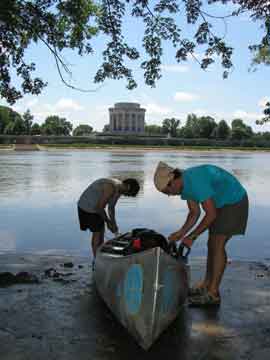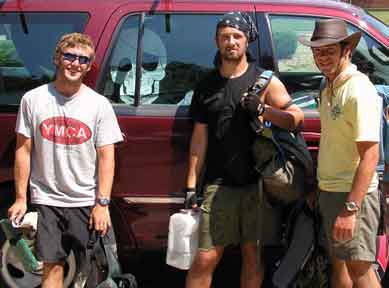Voices: On the Wabash |
|||
| Printer-friendly version | Email this article | |||
Juniors Homer Twigg, Zach Webb, and Clayton Craig spent 15 days of summer break paddling 400 miles to study the history, biology and aesthetics of the Wabash River. Two excerpts from their writings:
The TIPPEY
The people who seem to have the least are the most likely to feed you.—by Homer Twigg ’08
Not more than a mile from where the Tippecanoe River runs into the Wabash, my two partners and I saw two kids on the side of the river who had turned an old piece of rope into a human pendulum. The weather was hot and sticky and we were tired from two days of paddling a kayak and canoe on the river, so we decided to take a break and hope these kids were hospitable. I felt like Homer, coming battered upon the olive thickets of Phaeacia.
Both kids asked about our trip, and we told them about the Lilly Grant we received to research the river by traversing the whole thing. After 30 seconds their eyes began to dart inattentively, and mine drifted toward that rope swing over the river. So we stopped talking and got down to business.
First they recited "Mom’s rules"—a list of dos and don’ts to keep us safe on the rope. Then the first boy, about 10 years old, let us go. While in mid-air, I realized my situation: three college students on a rope swing with two kids no more familiar with me than I am with the Ohio River. The two kids were seeing what raw sunshine and muddy water can do to the psyche of three 20-year-olds. I felt like pure energy on the rope.
After a few jumps I wandered back to the older of the two boys and started asking him about life on the Wabash. He told me of the flooding and Asian Carp and the sandbars and their jon boat. He told me about the dangerous parts of the river "downstream the Tippey," treating what was 20 minutes away as though it were the edge of the world.Yet when I asked him about the Tippecanoe River a minute later, he had no idea what I was talking about. I explained to him that the proper name of the river was Tippecanoe. He shrugged it off and swung on the rope some more with us until we returned to the canoe to drip-dry.
Would Homer have said, "No gentlemen, it’s phay-EISH-ah. Look at the map?"
I wrote about this in my journal that night and slept like a ton of bricks.Two weeks later we were in southern Indiana. By the turns of the river and our compass, I figured we were in a place called Rising Sun, Illinois. I met some fishermen who invited me onto their boat, offered me a Stroh’s Lite, and told me their stories. I asked about Rising Sun.
They looked at me, puzzled, and said, "Rising Sun? You’re in Dogtown, boy."
I shrugged it off, wrote the real name of where I was on the atlas, and finished my drink.
First Photo: Zach Webb and Homer Twigg near the George Rogers Clark National Historic Park, Vincennes, IN
Lower Photo: Zach Webb, Homer Twigg, Clayton Craig and an ominous guest head back to the river.
|

 ON THE 400-MILE FLOAT on the Wabash River through Indiana and Illinois, you begin to have deja vu. I kept thinking, I’ve seen this quarter-mile stretch of phlox, sycamores, and water before. But it’s the people who live on this tired river who make her aged instead of old, seasoned and not filthy.
ON THE 400-MILE FLOAT on the Wabash River through Indiana and Illinois, you begin to have deja vu. I kept thinking, I’ve seen this quarter-mile stretch of phlox, sycamores, and water before. But it’s the people who live on this tired river who make her aged instead of old, seasoned and not filthy. Back on the boat, I had my first real revelation in a series that would follow like blows to the face on my trip down the Wabash River. Who am I to correct that kid? If someone came to my stomping ground and told me that I had the name wrong, I’d shrug them off, too.When it comes down to the essential characteristics of his home, who is the authority: his whole family and community calling the river one thing, or me, a scruffy, sandy stranger swearing that the map says otherwise?
Back on the boat, I had my first real revelation in a series that would follow like blows to the face on my trip down the Wabash River. Who am I to correct that kid? If someone came to my stomping ground and told me that I had the name wrong, I’d shrug them off, too.When it comes down to the essential characteristics of his home, who is the authority: his whole family and community calling the river one thing, or me, a scruffy, sandy stranger swearing that the map says otherwise?